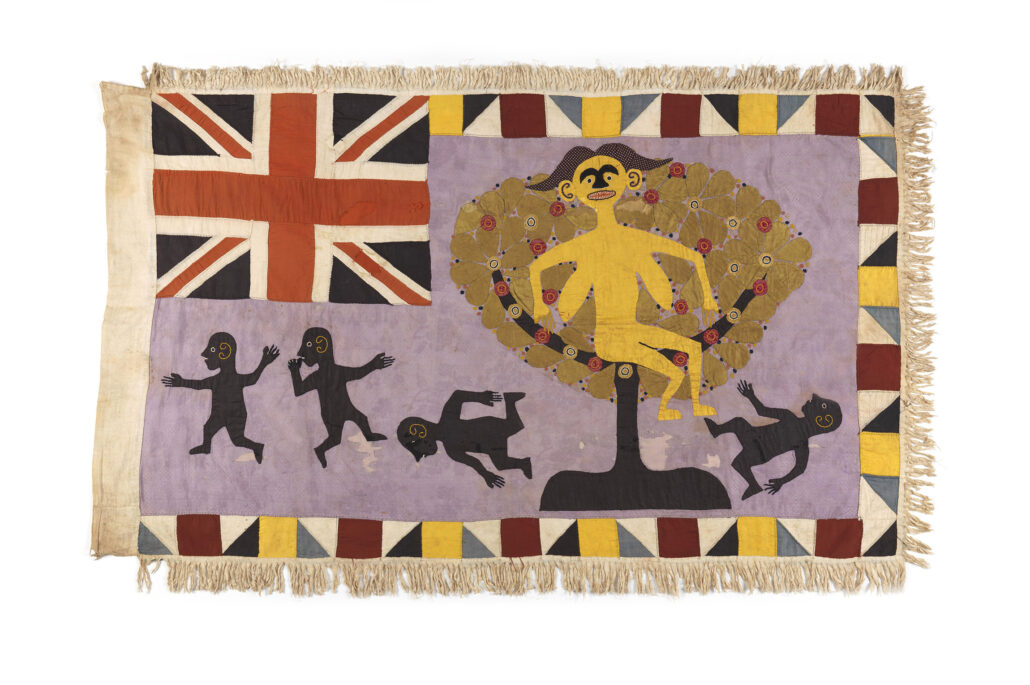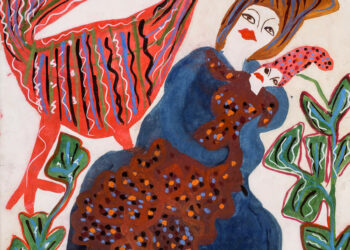Exuberant hand-sewn flags reflect cultural, political and social facets of contemporary Fante life.

Kwesi Budu, Kormantse workshop, Nkum No. 1 Company Abura Kunkwa, c. 1930. Cotton, synthetic fabric, silk; Fowler Museum at UCLA, X81.1640.
The presence of two fallen figures beneath a female figure in a tree is an indication that this is a representation of a sasabonsam, or a type of evil figure or dragon. This motif testifies to the often racist and sexist overtones of beliefs about and discussions of witches. Metaphors of wickedness and accusations of witchcraft are often employed to attack women who transgress boundaries prescribed for wives and mothers.
The Fowler Museum at UCLA presents ‘Art, Honor, and Ridicule: Fante Asafo Flags from Southern Ghana’, featuring 46 visually striking, hand-sewn flags made throughout the 20th century. Produced by the historical and still thriving Fante militia companies (or asafo) since at least the 18th century, the flags come alive in spectacular cultural events – across Ghana’s coastal towns and cities – that celebrate and preserve the memory of the companies’ role as community defenders.
Colourful and conceptually layered, asafo flags are adorned with vivid appliqué images that convey narratives of pride and superiority, visualise proverbial wisdom, and send defiant messages to enemies. Descriptive labels included with each flag on display translate their motifs and meanings, helping audiences to connect with the image and its cultural context. Each narrative textile reveals historical and sociopolitical facets of Fante life – a rich point of entry into the revered arts of Ghana. Asafo flags are highly regarded embodiments of Fante spirit and history, and have provided a generative reference for dozens of contemporary artists including Hank Willis Thomas, Grayson Perry, and George Afedzi Hughes.
The Fante are a subgroup of the Akan – the largest multiethnic group in Ghana – and share in the Akan visual lexicon, renowned for its staggering variety of proverbs, jokes, warnings, insults, and folktales. The flags on view are hung according to recurring themes and motifs, from lions, elephants, and other regional animals; boats, planes and bridges; to more nuanced narratives depicting ownership, technology, literacy, time, and gender.
In addition to 46 flags of similar size (around three by five feet), a single one-hundred-foot flag winds its way through the gallery at visitors’ eye level. Many asafo companies have at least one such showstopper, which several performers parade through the crowds in their respective communities. The Fowler installation briefly touches upon the spectacle of community flag performances, incorporating print-cloth costumes, video, and photographs – many taken by exhibition co-curator and incoming Shirley & Ralph Shapiro Director of the Fowler Museum, Silvia Forni. During these ritual events, flag dancers flaunt, throw, and roll flags in a choreography that evokes pride and boastfulness, a nod to battlefields of the past wherein companies were in frequent conflict with outsiders and with one another. Today, contemporary asafo companies compete against one another for bragging rights in energetic dance battles grounded in art, honor, and ridicule.
‘Art, Honor, and Ridicule: Fante Asafo Flags from Southern Ghana’ is co-curated by Silvia Forni, senior curator of global Africa, Royal Ontario Museum (ROM) in Toronto, and Erica P. Jones, Fowler curator of African arts, and features flags drawn exclusively from the Fowler collection. This presentation is based on the 2016 ROM exhibition of the same name, which focused on flags from ROM and was curated by Forni and Doran H. Ross, former director of the Fowler Museum. In 2017, a publication produced in cooperation between the two museums was published by ROM.
Lead support for the presentation at the Fowler Museum is provided by the Martha and Avrum Bluming Exhibition Fund, with generous funding from Barry and Jill Kitnick, the Doran H. Ross Fund for African Exhibitions, and the Marla C. Berns Exhibition Endowment. Additional support is provided by Saundra Lang.
Educational programming is made possible in part by the Nissan Foundation, The Ralph M. Parsons Foundation, Mara W. Breech Foundation, and the Winnick Family Foundation.
The exhibition is on view from the 23rd of October 2022 until the 12th of February 2023. For more information, please visit the Fowler Museum.



